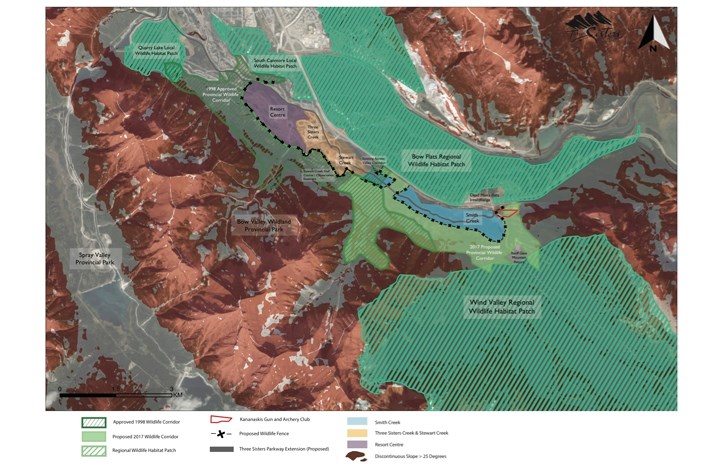A decision on the proposed Smith Creek wildlife corridor in Canmore by the provincial government is not expected any time soon, despite assurances in spring a decision would be forthcoming six to eight weeks after a public consultation process.
Now, officials with Alberta Environment and Parks are saying more time and further information from applicant Three Sisters Mountain Village is needed for a decision to be reached.
“Alberta Environment and Parks recognizes that the wildlife corridor and the future of the Three Sisters Mountain Village is important to the people of Canmore,” wrote Tim Chamberlin with AEP communications in an emailed statement to the Outlook. “A final decision on the wildlife corridor is expected in September, but this is only a current estimate. Given the complexity of the issue and amount of public feedback, more time may be necessary.
“We will be submitting a second round of clarifying questions to the developer. To ensure transparency in the process, questions and the answers provided will be posted online on the Alberta Parks website. Alberta Environment and Parks is taking time to make the best decision possible. The municipal election is not a factor in this decision.”
Mayor John Borrowman said this week he has personally written to AEP’s Roger Ramcharita – regional executive director for the South Saskatchewan region.
Borrowman said without the certainty a decision on the corridor proposal would provide, the upcoming municipal election will be affected by the lack of information and understanding of the issue.
“Until a decision is made, there is a lot of stuff we do not know,” he said. “It is disappointing they are stalling until after the election, which is what it is beginning to look like.
“That being said, I am encouraged to know the province is taking this issue as seriously as they are. I do not know how these processes have occurred in the past, but I am taking Mr. Ramcharita at his word that he is taking the time he feels is necessary to make the right decision and designate a corridor that remains functional for hundreds of years.”
The Smith Creek wildlife corridor is the final corridor required by the 1992 Natural Resources Conservation Board decision to grant development approval to Three Sisters as a land developer to build a resort centre and residential development on land in Canmore. The land was owned by the Canmore Mines Co. and significant areas of it were undermined as a result of the coal mining industry that kept Canmore going until 1979, when they shut for good.
The Resort Centre development area, for example, has significant undermining present, however, the Smith Creek area does not.
In addition to the NRCB decision, the Bow Corridor Ecosystem Advisory Group and its establishment of standards for corridors and habitat patches on the landscape have influenced wildlife corridor designation.
However, the BCEAG guidelines do not apply to Three Sisters lands subject to the NRCB decision because they are considered exempt. The patchwork approach to applying standards for landscape level decision-making by the province in the early ‘90s still leaves many in the community frustrated with the process.
Regardless, QuantumPlace principal and developer Chris Ollenberger has stated in the past the Smith Creek corridor proposal meets the definitions of appropriate corridor width and length under BCEAG.
Ollenberger, or a representative from TSMV, could not be reached for comment before the Outlook’s deadline.
Yellowstone to Yukon program director Stephen Legault, on the other hand, has challenged the corridor design as being deficient since it was publicly released.
Legault said he hopes the delay in the process means the province is performing its due diligence to fully understand the cumulative impacts of the corridor design and how it will affect the landscape on a broader, regional scale.
“What I am hoping is going on is the province is giving careful consideration to the broader concern of how the approval for the wildlife corridor configuration fits in with everything else that is going on with the Bow Valley right now,” he said.
The translocation of bear 148 in July by Fish and Wildlife from Canmore, for Legault, really speaks to the whole conversation Y2Y is trying to have around connectivity on the landscape.
“These issues are all part of the same conversation and my hope is that what is happening right now is the government is thinking about how these pieces of the puzzle fit together,” he said.
“We have certainly arrived at a tipping point for connectivity in the valley, because 148 should be able to live here, she should be able to move through this valley and she cannot.”
Working and making decisions at a larger scale than just this one valley, Legault said there are going to have to be hard decision made about the future, especially for places like Canmore.




